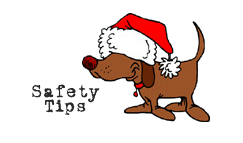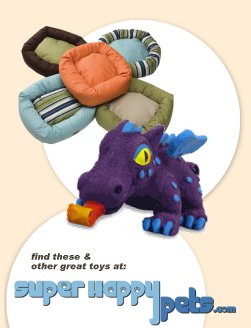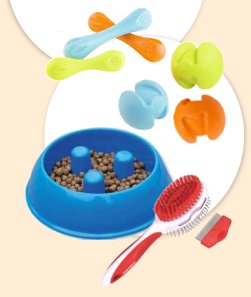| Please
visit http://www.doghealthnewsletter.com/newsletters/doghealthnews1.htm
if your email browser is not html-compliant, to view through your Internet browser. |
||||||||
 |
||||||||
| KEEPING
YOUR DOG SAFE & HEALTHY DURING THE HOLIDAYS: As the lyrics of a popular Christmas song go, "It's the most wonderful time of the year"... which is true for many people, but it can also be a time of stress and busy schedules. We have deadlines to meet, parties to enjoy, shopping, cooking-the list seems endless. As a result, our four-legged family members may be victims of these changes in our lives and can suffer from the lack of our time and proper attention. Animals are around for the holidays just like we are, and the stresses that impact human beings at this time also affect Man's...and of course, Woman's...Best Friend. |
 |
|||||||
| Since
dogs are creatures of habit, it's important that we maintain their routines
as much as possible. It may take a few sacrifices and some creative planning, but our doggies deserve proper attention and care to stay healthy. We may need to enlist the help of friends, family or neighbors to assist with our pets, especially if our schedule gets very hectic this time of the year. With some planning, we can ensure that pets and humans not only stay healthy, but thrive and enjoy the Holiday season. Full article: KEEPING YOUR DOG SAFE & HEALTHY... >> |
||||||||
 |
HANDY
CHECKLIST: COMMON HOLIDAY HAZARDS From artificial snow to mistletoe, from low-hanging ornaments to high-fat gravy, holidays and special occasions introduce a plethora of potential danger to your vulnerable canine. The good news is that you can dramatically reduce the risk of mishaps through proactive measures. Refer to this list - perhaps post it on the refrigerator or a handy place - to keep the holidays as safe and merry as possible. Full article: POTENTIAL HOLIDAY HAZARD LIST >> |
|||||||
 |
||||||||
|
WEST
PAW ORIGINAL BUMPER BED: Boy, did I win the jackpot! This bed
feels like it was made for royalty! So fluffy and soft, this bed keeps me cozy in style - so much so, in fact, that I've actually stopped taking up three-quarters of my human's bed every night. Don't tell her why, though, because in this bed, there is only room for one! … … … … SQUEEZE MEEZE DRAGON: Watch out, dog park, because I've got the neatest, meanest toy in the land! The Sqeeze Meeze Dragon not only looks cool, it feels cool, and even sticks out its tongue at the other dogs when I make it squeak. There's no doubt about it, stud - the Sqeeze Meeze is the beeez-neeez! … … … … HURLEY: You know, some days I just can't decide what I want to play with, and thanks to the Hurley, I don't have to. Bone, ball, or stick - this toy covers all the bases and pacifies my every mood. … … … … HUCK: Other dogs may be content with the same ol' back and forth, but I prefer a little excitement and unpredictability to my game. That's why the Huck ball is always with me. In the yard, at the park, even at the beach, you'll find me zig-zagging around, showing everyone what a real game of fetch looks like. And when a crazy bounce sends Huck heading towards the water, there's no need to panic. I know the ball will still be easy to find, floating along the top and begging me to retrieve. … … … … BREAK-FAST DOG BOWL: Okay, okay, I admit it-I used to be a scarfer, big time! Gobbled it down faster than you could say "chopped liver," but I just couldn't help it. Once that taste hit these chops, something just went off. My person tried a few things… like different dog food ...gross!…and less food ...are you crazy?…but for me, the Break-Fast Dog Bowl was the ticket. I still get my favorite food, but now it comes with an extra bonus: a little game of "cat and mouse" with the kibble. Plus, more of my day is dedicated to meal time now, and less of it is spent sprawled out across the hallway with belly aches. How great is that? … … … … DOG PIN BRISTLE BRUSH AND FLEA COMB: Soft, massaging fingers across my coat, bringing out my shine, so I always look my best - that's why I always come running when this new brush comes out of the cupboard! |
 |
|||||||
 |
||||||||
 |
||||||||
| Dear
Max, It seems Santa thought our home could use a second dog, and an annoyingly cute, spirited puppy at that. He keeps biting at my ears, slobbering on my toys, and stealing all MY attention. This does not make sense to me, and I am none too happy about it! How can I convince my humans that I am more than enough dog for this family? - Grrrrudgingly Yours … … … … |
 |
|||||||
| Dear
Grrrrudgingly Yours, I have been in your position before and, trust me, I understand how it feels at first. But let me tell you, if you can come to terms with the new addition, he might just turn out to be your trusted companion, playmate, and bark-ner in crime. That's how it is with my girl, Schatzi, whom my people brought home a while back. Now, there were a few things my people did-and yours can, too-to show what important and beloved members of the family we still are: First, they allowed me to maintain my identity. My kennel, for example, is all mine-no puppies allowed-and the same with my favorite snuggle spot and food bowl. My humans also bought Schatzi all her own toys so that she wouldn't keep coming after mine. Even now, we keep them pretty separate, except maybe when we're playing fetch together. Next, they were careful to make all of our interactions together positive experiences. It did not matter if they were trying to get Schatzi and me to play together, or just playing with us separately in the same room, they always made it rewarding with lots of treats, my favorite toys, and plenty of reassuring comments such as "good boy," "nice dog" and "we love you." They also stopped letting her do the little annoying stuff like nip at my ears after I made it clear that is definitely not something I am comfortable with. What can I say-I have my dignity, and I need my space, especially around my face. Last but not least, they made sure I still got my share of one-on-one dog/human time, with special ear rubs and snuggles dedicated to me and me alone. I love that time! But I have also come to love Schatzi, and I think the same can happen for you. With the help of your humans-and all those yummy treats-giving this little guy a shot might not be such a difficult and terrible thing after all! Max |
||||||||
 |
||||||||
 |
ASK
DR. SCHELLING DEAR DR. SCHELLING, Our one-year-old English Bulldog, Fergie, has developed a number of scabby sores and dry patches across the back of her neck, in the folds of her skin, and all around her nose. She scratches and licks at them endlessly, and they do not appear to be healing at all. Several have started to bleed, especially the ones close to her collar, and others are oozing some sort of pus. I am hoping you can tell me what the cause may be and what we can do to help heal the sores. - BURNING CONCERN |
|||||||
| Dear
Burning Concern, Skin diseases are one of the most common reasons owners bring their dogs to a veterinarian, and you have already gathered some important information your vet will need to begin the diagnosis of Fergie's problem. Breed, age, gender, overall health and any behavioral or environmental changes are important facts that can assist your vet in the proper diagnosis. It is important to understand that if a dog has a skin disease, there is often an underlying cause that has nothing to do with the skin. The skin is acting as a sentinel to signal that something else is wrong. It is important to take Fergie to your veterinarian for treatment of the symptoms...i.e. the sores, and even more important, to determine and treat the underlying cause so the sores do not recur. I would like nothing better than to give you a magic remedy to make Fergie feel better, but without knowing the cause, the remedy likely will not work. Fergie's skin is telling us that there probably is an abnormality in her body that needs to be treated. And if we do not know the cause, some treatments might make things worse. This is an extremely important concept, which I hope will help you understand Fergie's problem much better. Let's talk about a few of the things that can cause skin lesions. The skin, which is the largest organ of the body, has only a few limited responses to a wide variety of causes. For example, a dog with hypothyroidism - low thyroid levels - may have skin problems very similar to those of a dog with diabetes or hyperadrenocorticism - big word for another hormonal imbalance in dogs. This drives home the point that if we don't know the cause, we can't treat the disease effectively. If there are no underlying metabolic or hormonal problems, the most common cause of skin irritation in dogs is external parasites, most commonly, fleas. I know, I have heard it before - "My Dog does not have fleas!" But did you know there are many, many dogs who have a condition called Flea Allergy Dermatitis - FAD. These dogs are extra sensitive to fleas and exhibit an exaggerated response to flea bites. One flea bite can cause an allergic reaction in an FAD dog. So even if you don't see fleas, there is a possibility that fleas are the cause. Common symptoms of flea allergies include itching over the hips and tail area, the abdomen and inside the rear legs and armpits. The flea injects saliva when it bites the dog. Flea saliva is an anticoagulant as well as a protein. The problem is the protein from the saliva remains in the dog's system for two weeks and, if the dog is allergic to this protein, intense itching results. With FAD, the first line of defense is to be sure a high quality flea preventative is used monthly, following manufacturer's directions. Note that if a dog's skin is broken, more medication will be absorbed than would be through the skin of a healthy dog. This can lead to toxicity, especially with medications containing permethrins or pyrethrins. Again, this emphasizes the need to consult your veterinarian before starting any treatment. You are likely to hear from anyone you ask that if your dog has bad skin, it is a food allergy. This is a common misconception, and although food allergies definitely do occur, we find a food allergy component in only about 10 to 40 percent of dogs with allergies. Common symptoms of food allergies include facial itching, feet licking and chewing, and chronic ear infections. There are many pet food manufacturers that claim to offer a hypoallergenic diet. Dogs, like people, can be allergic to a variety of allergens, usually carbohydrates, proteins, and sometimes, preservatives. Unless a food trial is performed, feeding one protein, one carbohydrate at a time, it is not possible to determine which of the ingredients are triggering allergies. There is no "one size fits all" diet for dogs with allergies. Additionally, if you do not implement a proper food allergy feeding trial designed by your veterinarian, you may end up making Fergie allergic to even more types of food. This is a complicated subject which we will delve into further in subsequent issues. In short, don't just go out and buy a hypoallergenic diet as your version of a feeding trial. Another type of allergy is Atopy, a heritable allergy to environmental allergens, molds, pollens, grasses, weeds and trees, usually inhaled through the respiratory tract. Atopic dogs generally show symptoms beginning around the age of two. At first the symptoms seem to be seasonal, but recur with longer and more severe episodes. Diagnosis can be made with blood work and allergy testing. Owners should know that these dogs are never cured, but can be very well controlled with life-long therapy. Since this is a condition that can be passed on to offspring, these pets should be spayed or neutered. Regardless of cause, skin irritations have a high potential for secondary bacterial and/or yeast infection. Any secondary infections will need to be treated as well as the cause. Your vet may very well be treating two separate conditions. One treatment for the cause of the lesions - sores, and the second treatment, a palliative and therapeutic treatment to soothe the lesions resulting from the primary cause. Medications to control itching can help improve Fergie's (and your) quality of life. Gentle hypoallergenic shampoos help to reduce the allergen load and improve overall skin health. Omega 3 fatty acids have proved to be vital to pets' overall health, especially with regard to the skin. I realize that this is a long answer that didn't really give you a cure, but I hope it will help you understand that Fergie's skin can act as a sentinel organ to tell you and your veterinarian that something internal may be out of balance. The sooner the cause is diagnosed, the better for all concerned. |
||||||||
| What
topics would you like to see covered in future issues of the Dog Health
Newsletter? Let us know at: comments@doghealthnewsletter.com |
||||||||
| SPOT
SHOT: TIPS FOR TAKING BETTER PET PHOTOS "Say cheese!" Okay, maybe not "cheese." If your dog is anything like mine, that word may be a little distracting-but then again, that immediate snap to attention may be exactly what you need to get a great photo of your pet. This month we want to help you get the right shot, whether you are looking for something to send along with this year's annual holiday card, wanting to take advantage of the season's decorations to create the perfect festive look for next year's card, or just hoping to capture another great piece for the mantle. Full article: TIPS FOR TAKING BETTER PET PHOTOS >> |
 |
|||||||
 |
||||||||
|
Copyright © 2006-2009 • The Dog Health
Newsletter • Dr. Christianne Schelling • All
Rights Reserved Disclaimer: This website is not intended to replace professional consultation, diagnosis, or treatment by a licensed veterinarian. If you require any veterinary related advice, contact your veterinarian promptly. Information in the Dog Health Newsletter and at Doghealth.com is exclusively of a general reference nature. Do not disregard veterinary advice or delay treatment as a result of accessing information at this site. Terms of Use |
||||||||